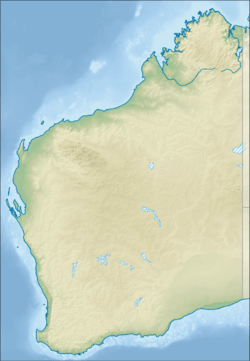Lake Muir facts for kids
Quick facts for kids Lake Muir |
|
|---|---|

Lake Muir in October 2010
|
|
| Location | South West, Western Australia |
| Coordinates | 34°26′49″S 116°44′54″E / 34.44694°S 116.74833°E |
| Primary outflows | Deep River |
| Catchment area | 384 km2 (148 sq mi) |
| Basin countries | Australia |
| Designation | Muir-Byenup System Ramsar Site |
| Max. length | 11 km (6.8 mi) |
| Max. width | 5 km (3.1 mi) |
| Surface area | 46 km2 (18 sq mi) |
| Surface elevation | 170 m (560 ft) |
Lake Muir is a special freshwater lake in Western Australia. It's surrounded by a huge area of wetlands. Think of wetlands as areas where the land is covered by water, either all the time or just for a season. They are super important for nature!
This lake is found in the South West part of the state. It's located near Muirs Highway, which is north of Walpole and southeast of Manjimup.
Contents
What is Lake Muir Like?
Lake Muir covers an area of about 46 square kilometres (18 sq mi). That's like 4,600 football fields! The lake and its surrounding wetlands are part of a bigger area called the Lake Muir-Byenup System. This whole system is 694 km2 (268 sq mi) and includes many different wetland areas.
Usually, Lake Muir has slightly salty water at the end of winter. This is called "brackish" water. By summer, it gets even saltier. Then, during autumn, it often dries up completely.
Sometimes, when there's a lot of rain, Lake Muir can overflow. Its water might flow into the Deep River. It could also flow into the Frankland River through a place called Poorginup Gully.
Animals and Plants at Lake Muir
A large part of the wetland around Lake Muir is a very important place for birds. It's been named an Important Bird Area (IBA) by BirdLife International. This means it's a crucial spot for birds around the world.
Who Lives Here?
This wetland is home to at least 10 pairs of endangered Australasian bitterns. These are shy birds that look a bit like herons. The wetlands here are shallow, with lots of dense sedges (grass-like plants) and bushes. There are also stands of trees around the edges.
Even though Lake Muir itself isn't perfect for bitterns, it's great for other birds. Many Australian Shelduck live there. It might even be one of the most important places globally for this type of duck!
History of Lake Muir
Lake Muir got its name from two brothers, Thomas and John Muir. They were some of the first European settlers in this area. They moved to a place called Deeside in 1852, which was about 25 kilometres (16 mi) west of the lake.
Protecting the Lake
For a long time, the area around Lake Muir was a Game Reserve. This meant people could hunt ducks there during a special season. The Department of Environment and Conservation (CALM) started watching the wetlands in 1980. They wanted to make sure the duck hunting was managed properly.
On January 5, 2001, a big area of 106-square-kilometre (41 sq mi) around Lake Muir was given a special status. It became a Ramsar site, which means it's a wetland that is important all over the world. This was because of its amazing variety of plants and animals. In the same year, the Government of Western Australia also made it the Lake Muir Nature Reserve. This helps protect the area even more.
Earthquakes at the Lake
Lake Muir has also been the center of some earthquakes. On September 16, 2018, there was a magnitude 5.7 earthquake. This was followed by a magnitude 4.7 quake on October 13, and another 5.4 quake on November 9.


